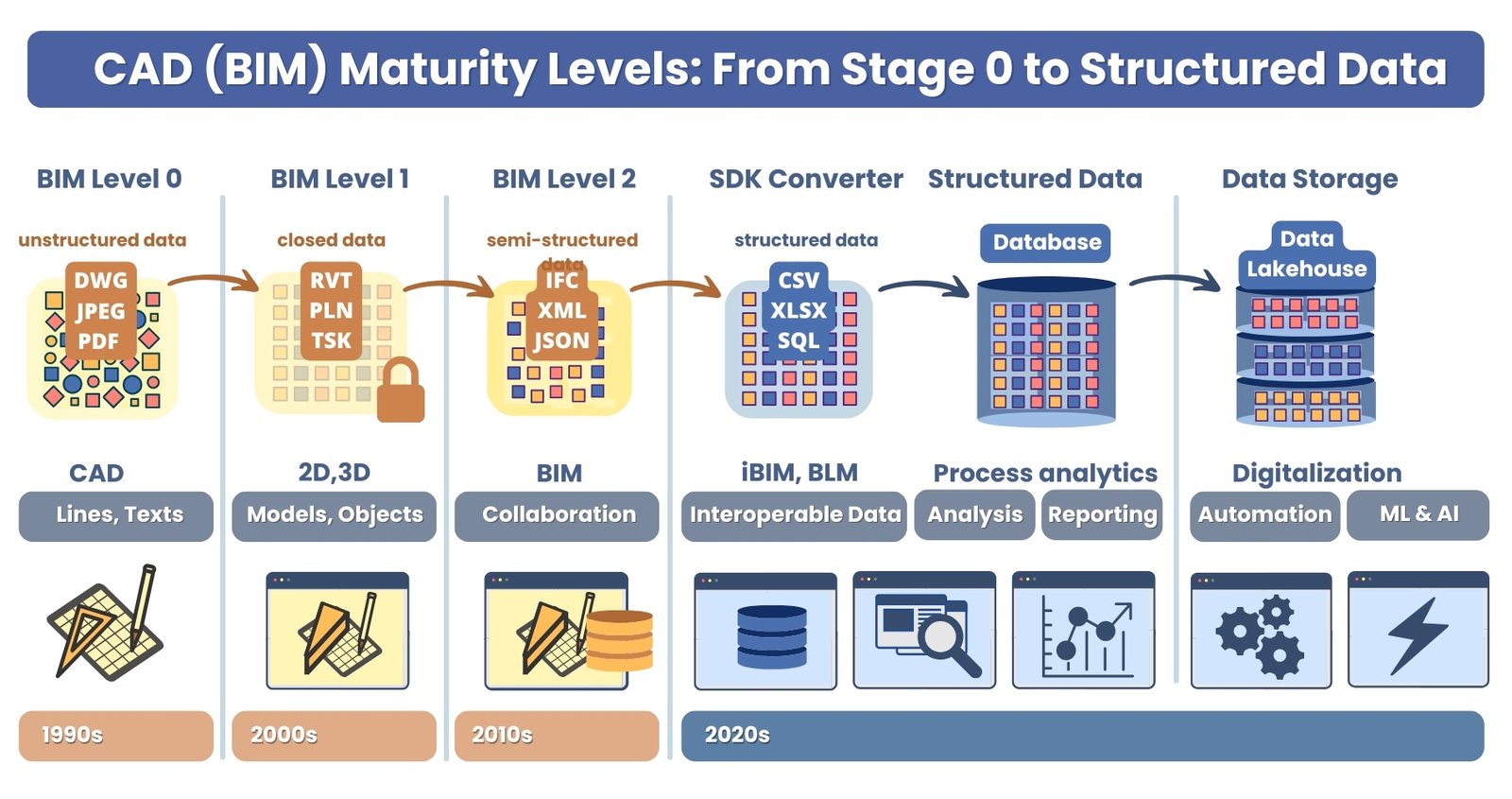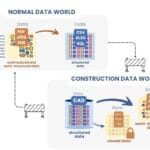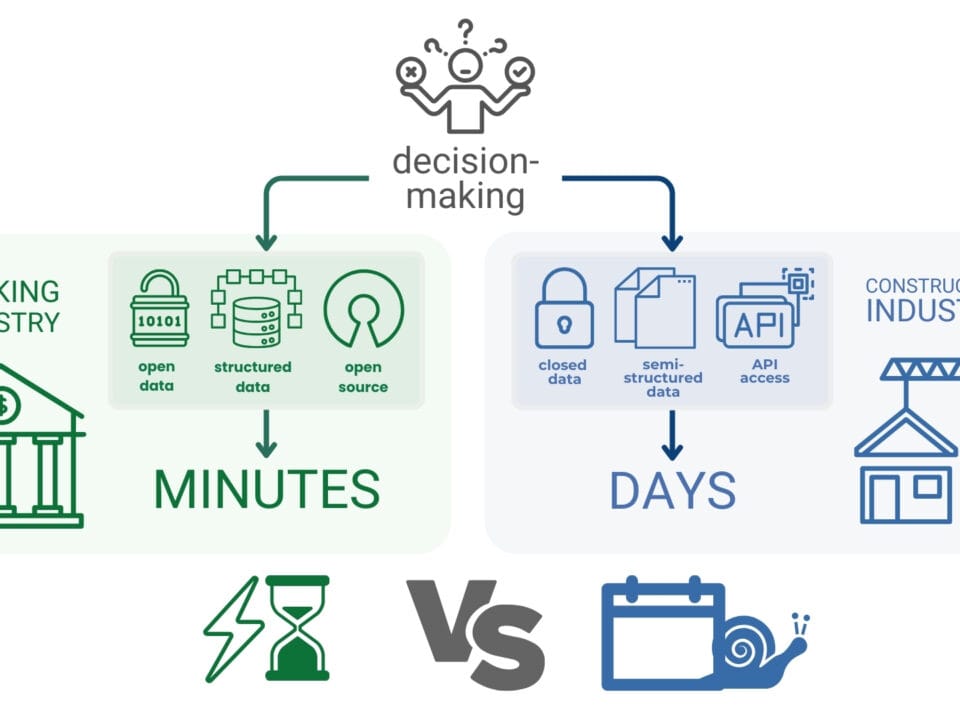The emergence of the AOUSD alliance (Apple.com, “Pixar, Adobe, Apple and NVIDIA form Alliance for OpenUSD to drive open standards for 3D content,” August 1, 2023) in 2023 marks an important turn in the construction industry. We are witnessing the beginning of a new realityshaped by CAD vendors in dealing with construction data through several significant changes. The first major change concerns the perception of CAD -data. Professionals involved in the early stages of conceptual design are increasingly realizing that creating a design in a CAD environment is only a starting point. The data generated during the design process eventually becomes the basis for analyzing, operating, and managing facilities. This means that they must be accessible and usable in systems beyond traditional CAD tools.
In parallel, a revolution in the approach of leading developers is taking place. The industry’s leading CAD- vendor, which created the BIM concept and the IFC format, is making an unexpected turn in its strategy. From 2023, the company is moving away from the traditional storage of data in separate files, focusing on working with granular (normalized and structured) data with a transition to a data-centric approach(AECmag, “ADSK’s granular data strategy,” 25 Jul 2024).
Vendors are following the historical trends of other industries: most users don’t need closed CAD formats (similar to PSD) or complex parametric IFC files (similar to GIMP with layer logic). They need simple object images that can be used in CAFM (construction Instagram), ERP (Facebook) and thousands of other processes filled with Excel spreadsheets and PDF documents.
Current trends in the construction industry are potentially setting the stage for a gradual shift away from parametric and complex formats in favor of more universal and independent formats USD, GLTF, DAE, OBJ (with meta-information both within hybrid and in separate structured or loosely structured formats). Historical leaders, including major design companies that once actively promoted IFC in the mid-1990s, are now openly promoting the new USD format (А. Boiko, “The Age of Change: IFC is a thing of the past or why ADSK and other CAD vendors are willing to give up IFC for USD in 14 key facts,” 24 November 2024), emphasizing its simplicity and versatility (Fig. 6.2-6). The mass adoption of USD in products, GLTF compatibility, and active integration into tools such as Blender, Unreal Engine, and Omniverse indicate the potential for the beginning of a new paradigm for working with data. Along with the popularity of localized solutions such as the European flat USD format – CPIXML, used in popular European ERPs could potentially strengthen the USD position in Central Europe. Organizations involved in the development of the IFC format are already adapting their strategy to USD (А. Boiko, “The Age of Change: IFC is a thing of the past or why ADSK and other CAD vendors are willing to give up IFC for USD in 14 key facts,” 24 11 2024), which only confirms the inevitability of the shift.

Against this background, USD has the potential to become the de facto standard, promising to overcome many current limitations, primarily related to the complexity of existing CAD – (BIM-) formats and the dependence of their interpretation on geometric kernels.
Instead of parametric and complex CAD -formats and IFC – simplified data formats USD, gLTF, DAE, OBJ with element meta-information in CSV, XLSX, JSON, XML will gain a place in the construction industry due to their simplicity and flexibility.
Current changes in the construction industry at first glance look like a technological breakthrough associated with the transition from the aging IFC to the more modern USD. However, it should be taken into account that back in 2000 the same CADvendor, which developed IFC, wrote about its problems and the need for access to the database (ADSK, “Integrated Design-Through-Manufacturing: Benefits and Rationale,”), and now actively promotes the transition to the new standard- USD.
Behind yet another facade of “open data” USD and “new” concepts for granular data management, through cloud-based applications that CAD vendors are starting to promote may hide the vendors’ intention to monopolize project data management, where users find themselves in a position where the choice of format has more to do with corporate interests than real-world needs.
An analysis of key facts (А. Boiko, “The Age of Change: IFC is a thing of the past or why ADSK and other CAD vendors are willing to give up IFC for USD in 14 key facts,” 24 November 2024) shows that the main goal of these changes israther less about user convenience than primarily about maintaining control over ecosystems and data flows for the benefit of vendors who, in 40 years, have never been able to provide access to CAD databases.
Perhaps now is the time for companies to stop waiting for new concepts from software vendors and focus on self-development in the data-centric direction. Having freed itself from data access problems through reverse engineering tools, the industry will be able to move independently to modern, free and convenient tools for working and analyzing data without imposing new concepts.

Access to databases, open data and formats will inevitably become a standard in the construction industry, regardless of vendors’ attempts to stall the process – it is only a matter of time (Fig. 6.2-7). The pace of this transition can increase significantly if more and more specialists become familiar with open formats, database tools and available reverse engineering SDKs, which allow organizing direct access to CAD data-systems (“Members: Founders and corporate members,” 2024).
The future lies in open, unified and analytically accessible data. To avoid dependence on vendor solutions and to avoid being held hostage to closed ecosystems, construction and engineering companies will sooner or later have to rely on openness and independence, choosing formats and solutions that provide full control over data.
The data that is being created in the construction industry today will be a key resource for business decisions in the future. It will act as the strategic “fuel” that fuels the development and efficiency of construction companies. The future of the construction industry lies in the ability to work with data, not in the choice of data formats or models.
To understand the difference between open formats USD, glTF, DAE, OBJ and proprietary parametric CAD formats, it is important to consider one of the most complex and key data elements in visualization and design calculations – geometry and its generation processes. And to understand how geometry data becomes the basis for analytics and calculations in construction, it is necessary to further explore the mechanisms of geometry generation, transformation and storage.




















